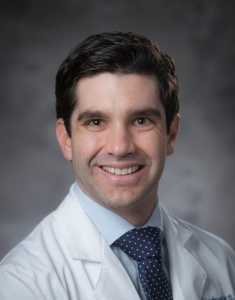Thyroidectomy (Cadaver)
Abstract
Thyroidectomy may be performed for various pathologies, consisting of either thyroid lobectomy or total gland removal. Both benign and malignant disease processes necessitate surgical intervention. Thyroid nodules, compressive thyroid goiter, or persistent thyrotoxicosis represent some of the benign indications. Malignant conditions affecting the thyroid include papillary, follicular, medullary, and anaplastic carcinomas. In the present case, a thyroidectomy via standard cervical incision is performed on a cadaver with overlying animations to emphasize the key anatomy. The discussion is in relation to a patient with obstructive goiter presenting with worsening wheezing, cough, and dysphagia, with the ultimate goal of relieving the compressive symptoms through the removal of the gland.
Keywords
Thyroidectomy; thyroid disease; cadaver; otolaryngology; education.
Case Overview
Background
Patients with thyroid pathology may present with variable symptoms, including difficulty breathing, voice changes, or endocrine issues. Others may have no symptoms, as the incidental diagnosis of thyroid nodules occurs with some frequency. Obstructive symptoms such as exertional dyspnea, wheezing, or cough often warrant urgent intervention. Rapidly growing thyroid glands should alert the clinician to an underlying malignant process.1
Patients with endocrine pathology may demonstrate hyperthyroid symptoms (palpitations, myopathies, weight loss, heat intolerance, diarrhea, amenorrhea) or hypothyroid symptoms (constipation, brittle nails, cold intolerance). Medical management targeted at downstream relief or thyroid suppression/supplementation may be sufficient.2
Thyroid malignancies may or may not have a palpable mass in the thyroid. Specific criteria for biopsy of a thyroid nodule include a size greater than 1.5 cm or concerning signs on ultrasound (irregular borders, microcalcifications, central vascularity). The Bethesda classification system helps guide the specific recommendations for surgery or observation.3 The Bethesda classification system classifies thyroid nodules into six categories based on findings from fine needle aspiration (FNA): nondiagnostic, benign, atypia or follicular lesion of undetermined significance, follicular neoplasm or suspicion for follicular neoplasm, suspicious for malignancy, and malignant. Each category corresponds to a different cytopathology and risk of malignancy, and so there are different treatment options based on the Bethesda classification and patient specific factors.
In patients with obstructive goiter, a slow-growing mass is typical, to the point where symptoms of tracheal and esophageal compression are brought on slowly: exertional dyspnea, wheezing, cough, and dysphagia. These symptoms often present when the trachea is compressed and its diameter becomes less than 8 mm. Less commonly, acute compressive symptoms of a thyroid goiter have been reported.4,5 Compressive symptoms caused by an enlarged thyroid, whether cancerous or noncancerous, should be treated via thyroidectomy. Longstanding compression can result in structural changes to the underlying cartilaginous framework of the airway, and postoperative tracheomalacia may warrant additional intervention.
Focused History of the Patient
Our case scenario is of a patient with a slow-growing thyroid gland over many years presenting with several weeks of worsening wheezing, cough, and dysphagia. The patient was previously evaluated by the primary care provider for concern of an enlarged thyroid, but screening TSH and T4 levels were normal, no compressive symptoms were present at that time, and ultrasound indicated no further workup. When the patient presented a second time a decade later, the patient had no complaints of palpitations, anxiety, diarrhea, constipation, cold or heat intolerance, or other concerns. The patient was most distraught by difficulty swallowing and breathing. Further history elicited that the patient had particular trouble breathing when laying supine.
Physical Exam
In a patient with an obstructive goiter, enlargement may be visible or palpable. Unilateral or bilateral enlargement should influence the differential diagnosis. Signs of underlying endocrine issues (exophthalmos, thin/brittle hair or nails, and skin quality) should be assessed. For any patient being worked up for surgical intervention, the mobility of the vocal cords should be documented with flexible fiberoptic laryngoscopy.
Diagnostic Tests and Imaging
Patients presenting for surgery should be euthyroid, with any abnormalities identified and managed prior to surgery. TSH and free T4 should be done and within normal limits. Thyroid ultrasound would be homogenous without indications for FNA. Computed tomography (CT) may show compression into the trachea, esophagus, or surrounding structures. Ancillary tests may include thyroid-stimulating autoantibodies, anti-thyroid peroxidase, calcitonin, and a barium swallow.
Natural History
The natural history of obstructive thyroid is a slowly-enlarging mass. Removal is indicated when a patient has signs of compression. Research has not shown that removal of non-obstructive goiter provides decreased mortality to a patient, and the risks may be greater than any benefit.6
Options for Treatment
- Hormonal suppression for small goiters
- Iodine replacement (for multinodular goiter with iodine deficiency)
- Radioactive iodine therapy
- Surgical excision
Rationale for Treatment
The ultimate goal is to remove the compressive thyroid to relieve symptoms.
Special Considerations
Contraindications to thyroidectomy are uncontrolled Grave’s disease, due to concern of intraoperative or postoperative thyroid storm, and Riedel’s thyroiditis, due to fibrotic tissue and complications associated with removal including hypoparathyroidism.
Step-by-Step Technique
Preoperative
The patient should be consented to surgery after understanding the risks that are specific to total thyroidectomy. The risks include bleeding, infection, scarring, pain, hypothyroidism (and the need for lifelong hormone replacement), possible hypoparathyroidism, and problems related to calcium metabolism that may be transient or permanent, possible recurrent laryngeal nerve (RLN) injury resulting in dysphonia, dyspnea. In the possible event of bilateral RLN injury, a tracheostomy may be necessary. Dysphagia may be present after surgery as well.
With the patient sitting upright, an incision just below the level of the cricoid cartilage in a natural skin crease can be marked.
Anesthesia
The preferred anesthesia method for this surgery is general anesthesia with endotracheal intubation. Specifically, an endotracheal tube with electrodes in contact with the bilateral vocal cords to monitor for RLN activity and no paralytic agents should be used when Intraoperative nerve monitoring is employed.
Patient Positioning
Patients should be faced supine with straps securing them to the bed. A shoulder roll or bolster is placed between shoulders to hyperextend the neck slightly for access to the surgical region. Head can be placed in a head-ring for stabilization. The table can be positioned either flat or tilted to 30° anti-Trendelenburg to minimize venous engorgement.
Prepping the Patient
Facility preferred preparation methodology can be used (e.g., betadine, chlorhexidine) for skin disinfection before the incision is made.
Procedure Details
A curvilinear incision is made two fingerbreadths above the sternal notch, within a natural crease of the patient’s neck determined prior to incision. The underlying subcutaneous fat and platysma are divided to expose the underlying strap muscles. Then, the fascia between the sternohyoid and sternothyroid muscles is divided at the midline to identify the anterior surface of the thyroid. Once this is complete, the trachea and isthmus are identified. The exposed thyroid is rotated medially to expose and divide then ligate the middle thyroid veins. Next, the superior pole of the thyroid is exposed to bring the superior thyroid artery into view, dividing it out as closely as possible to the thyroid parenchyma to avoid injury to the superior laryngeal nerve. The superior parathyroids are brought into view with the delivery of the superior pole; they should be preserved. Retractors should then be shifted to view the inferior thyroid veins which allow ligation of the veins and then identification of the inferior parathyroid glands. It is vital to identify and preserve the RLN, found within Simon’s triangle (made up of the common carotid laterally, esophagus medially, and inferior thyroid artery superiorly). All branches of the inferior thyroid artery should be carefully divided and ligated. Next, reidentifying the RLN posterior to the ligament of Berry is vital before sharply dissecting the ligament from the trachea. For a total thyroidectomy, all the above steps should be repeated for the opposite side.
Dressing
The surgical site is irrigated, and the Valsalva maneuver is done to ensure appropriate hemostasis. A wound drain may be applied and secured to the skin with a 3-0 nylon suture. The strap muscles are approximated for 70% length, and the platysma is closed with absorbable 3-0 Vicryl stitches. Subcuticular skin closure is achieved with absorbable 4-0 Monocryl running suture. A light dressing is applied with antibiotic ointment and Steri-Strips, or Dermabond.
Postoperative Restrictions
Patients must be monitored for bleeding and airway obstruction, in addition to endocrine symptoms. A normal diet is preferred, as tolerated. Following a total thyroidectomy as in this case, serum PTH is obtained in the recovery area, as well as a baseline calcium value (whole blood versus ionized). A postoperative PTH level <15 pg/mL on postoperative day 1 would suggest an increased risk for acute hypoPT, which might prompt prescribing of oral calcium and calcitriol and/or serial serum calcium measurements until calcium stability has been confirmed. Patients whose PTH is <15 pg/mL, serum calcium is <8.5 mg/dL, or ionized Ca is <1.1 mmol/L should be considered for postoperative oral calcium supplementation (400–1200 mg per day of elemental calcium which is equivalent of 1–3 g of calcium carbonate; 2–6g calcium citrate per day) administered orally in divided doses.11
If a drain was placed, removal of the drain occurs when output is less than 30–50 ml over 24 hours. The morning after surgery, thyroid hormone supplementation should be initiated. The dose for this is based on ideal body weight and may be increased for malignant pathologies to aid in TSH suppression. Subsequent management to ensure appropriate dosing should be carried out with an endocrinologist.7,8
Potential Complications
Potential complications include hypocalcemia, vocal cord paralysis, postoperative hematoma or infection, and transverse neck scar.
Discussion
We present here a case of a patient with obstructive goiter undergoing thyroidectomy simulated on a cadaver with overlying illustrations to better appreciate the procedural steps and anatomy of the region. In summary, our patient presented with several weeks of worsening wheezing, cough, and dysphagia, and a visibly enlarged thyroid on the exam. TSH and T4 screening labs were within normal limits, and ultrasound did not show evidence of the need for a biopsy. CT showed evidence of compression on the trachea and the esophagus. The ultimate goal of therapy is the removal of the compressive thyroid gland while preserving the parathyroid glands and RLN. Post-surgery, patients require thyroid hormone supplementation, and immediate labs must be monitored to ensure appropriate calcium homeostasis.
This case depicts a standard cervical incision thyroidectomy. Additional procedures include transoral endoscopic thyroidectomy vestibular approach (TOETVA) and transaxillary robotic thyroidectomy.9,10 Indications for TOETVA include thyroid is less than 10 cm, benign tumor, follicular neoplasm, papillary microcarcinoma, Graves’ disease, and substernal goiter grade 1. The transaxillary approach is primarily used for papillary thyroid microcarcinoma, in addition to expansion to papillary thyroid cancer. These alternative types of thyroidectomy can be extremely efficient however, the standard cervical incision approach offers a broader inclusion criterion. Additionally, while the thyroid is an extremely vascular organ with many vital nerves and structures surrounding it, the procedure has extremely low morbidity with the meticulous care taken for hemostasis and antisepsis.
Equipment
Basic head and neck tray.
Duke University Cadaver Lab Series
Check out the rest of the series below:
- Functional Endoscopic Sinus Surgery: Maxillary, Ethmoid, Sphenoid (Cadaver)
- Ethmoid Artery Anatomy (Cadaver)
- Frontal Sinus Dissection (Cadaver)
- DCR and Nasolacrimal System (Cadaver)
- Parotid Dissection (Cadaver)
- Thyroidectomy (Cadaver)
Disclosures
C. Scott Brown also works as editor of the Otolaryngology section of the Journal of Medical Insight.
Statement of Consent
This case is a thyroidectomy demonstrated on a cadaver; no consent was required. All other persons seen in the video consented to publication of the media.
Citations
- Pellitteri PK, Goldenberg D, Jameson B. Disorders of the Thyroid Gland. In: Cummings Otolaryngology: Head and Neck Surgery. 7th ed. New York, NY: Elsevier; 2021:1852-68.
- Lee JC, Gundara JS, Sidhu SB. The Thyroid Gland. In: Endocrine Surgery. 5th ed. New York, NY: Elsevier: 2014:41-69.
- Cibas ES, Ali SZ. The Bethesda System for reporting thyroid cytopathology. Am J Clin Pathol. 2009;132(5):658-665. doi:10.1309/AJCPPHLWMI3JV4LA.
- Sharma A, Naraynsingh V, Teelucksingh S. Benign cervical multi-nodular goiter presenting with acute airway obstruction: a case report. J Med Case Rep. 2010;4:258. doi:10.1186/1752-1947-4-258.
- Ito T, Shingu K, Maeda C, et al. Acute airway obstruction due to benign asymptomatic nodular goiter in the cervical region: a case report. Oncol Lett. 2015;10(3):1453-1455. doi:10.3892/ol.2015.3464.
- Knobel M. Which is the ideal treatment for benign diffuse and multinodular non-toxic goiters?. Front Endocrinol. 2016;7(48). doi:10.3389/fendo.2016.00048.
- Liu YF, Simental A. Open Thyroidectomy. In: Operative Otolaryngology Head and Neck Surgery. 3rd ed. New York, NY: Elsevier; 2018:527-34.
- Panieri E, Fagan J. Thyroidectomy. In: Open Access Atlas of Otolaryngology: Head and Neck Operative Surgery. University of Capetown.
- Patel D, Kebebew E. Pros and cons of robotic transaxillary thyroidectomy. Thyroid. 2012;22(10):984-985. doi:10.1089/thy.2012.2210.ed.
- Russell JO, Sahli ZT, Shaear M, Razavi C, Ali K, Tufano RP. Transoral thyroid and parathyroid surgery via the vestibular approach-a 2020 update. Gland Surg. 2020;9(2):409-416.
doi:10.21037/gs.2020.03.05. - Orloff LA, Wiseman SM, Bernet VJ, et al. American Thyroid Association statement on postoperative hypoparathyroidism: diagnosis, prevention, and management in adults. Thyroid. 2018;28(7):830-841. doi:10.1089/thy.2017.0309.




